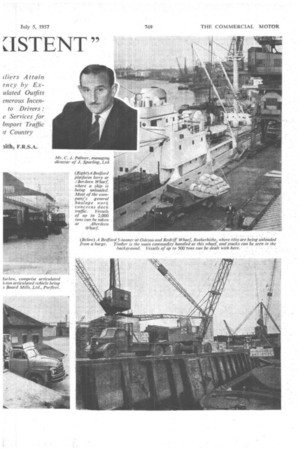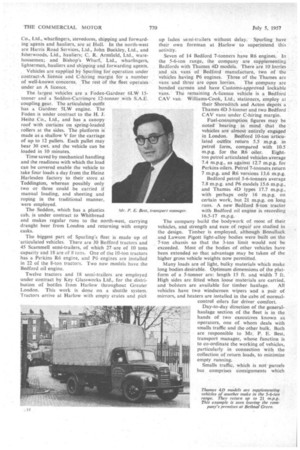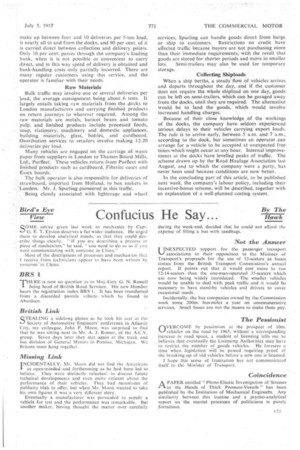EMPTY RUNNING NON
Page 54

Page 55

Page 56

Page 59

If you've noticed an error in this article please click here to report it so we can fix it.
a ST ENT " BUSINESSLIKE methods in all departments, extending from executives to individual drivers, . whose efforts and acumen are encouraged by a generous bonus sche.ne, are followed by J. Spading, Ltd.;. Peel Grove, London, E.2. Their 72 vehicles carry 9001,000 tons a,day and cover more than 28,000 miles a week, mainly in the London area. Advantages of articulated vehicles are exploited, and empty running is almost non-existent, claims Mr. C. J. Palmer, managing director. . The company are a subsidiary of Transport Development Group, Ltd., and thereby affiliated to a number of other concerns in London, Hull and the north-west. Those in London aNe. the General Lighterage Co., Ltd., lightermen. and shipping and forwarding agents; Ham Wharfage, Ltd., Trinity Wharf Co., Ltd., and John Dudin and Sons, Ltd., wharfingers and hauliers; I. Lettley, Ltd., hauliers; Winkley's Wharfage Co., Ltd., oil and general wharfingers; and Thames Wharves and Warebduses,Ltd., wharfingers. There are also the
Thames Dry Dock and Engineering Co., Ltd., ship and barge repairers, and Thames Packers, Ltd., packers and casemakers.
Spurling have 20,000 sq. ft. of warehousing space at Peel Grove, and are also wharfingers. Aberdeen Wharf, Limehouse, can take vessels of up to 2,000 tons and has storage facilities. Timber is the main commodity dealt with at Odessa and Redriti Wharf, Rotherhithe, which can accommodate vessels of up to 500 tons, and flour and grain pass through Winchester Wharves, Southwark, where ships of up to 250 tons can unload. Barges 4re handled at all these wharves.
Ninety per cent. of Spurling's general haulage. work concerns export and import traffic to and from the London docks. In Hull and the• north-west, the associated companies are of sirhilar character, and facilities thus exist for providing comprehensive transport and associated services, including Customs arrangements, for importers and exporters.
Fred Oldridge, Ltd., lighterrnen, and Wm. Gilyott and Co., Ltd., wharfingers, stevedores, shipping and forwarding agents and hauliers, are at Hull. In the north-west are Harris Road Services, Ltd., John Buckley, Ltd., and Isherwoods,. Ltd., hauliers; C. R. Armfield, Ltd., warehousemen; and Bishop's Wharf, Ltd., wharfingers, lighterrnen, hauliers and shipping and forwarding agents.
Vehicles are supplied by Spurling kit operation under contract-A licence and C-hiring margin for a number of well-known concerns. The rest of the fleet operates under an A licence.
The largest vehicles are a Foden-Gardner 6LW 15tanner and a Seddon-Carrimore. 12-tanner with S.A.E. coupling gear. The articulated outfit has a Gardner 5LW engine. The Foden is under contract to the H. 31 Heihz Co., Ltd., and has a canopy roof with curtains on spring-loaded rollers at the sides. The platform is made as a shallow V for the carriage of up to 12 pallets. Each pallet may bear 30 cwt. and the vehicle can be loaded in 10 minutes.
Time saved by mechanical handling and the readiness with which the load can be covered enable the vehicle to take four loads a day from the Heinz Harlesden factory to their store at Teddington, whereas possibly only two or three could be carried if manual loading, and sheeting and roping in the traditional manner, were employed.
The Seddon, which has a plastics cab, is under contract to Whitbread and makes regular runs to the north-west, carrying draught beer from London and returning with empty casks.
The biggest part of Spurling's fleet is made up of -articulated vehicles. There are 30 Bedford tractors and 45 Scammell semi-trailers, of which 27 are of 10 tons capacity and 18 are of 8 tons. One of the 10-ton tractors has a Perkins RO engine, and PO engines are installed in 22 of the 8-ton tractors. Two new models have the Bedford oil engine.
Twelve tractors and 18 semi-trailers are employed under contract by Key Glassworks Ltd., for the distribution of bottles from Harlow throughout Greater London. This work is done on a shuttle system. Tractors arrive at Harlow with empty crates and pick up laden semi-trailers without delay. Spurling have their own foreman at Harlow to superintend this activity.
Seven of 14 Bedford 7-tonners have R6 engines. In the 5-6-ton range, the company are supplementing Bedfords with Thames 4D models. There are 10 lorries and six vans of Bedford manufacture, two of the vehicles having P6 engines. Three of the Thames are vans and three are open lorries. The company are bonded carmen and have Customs-approved lockable vans. The remaining A-licence vehicle is a Bedford CAV van. Williams-Cook, Ltd., stationers, employ at their Shoreditch and Acton depots a Thames 4D 3-tonner and two Bedford . CAV vans under C-hiring margin.
Fuel-consumption figures may be noted bearing in mind that the vehicles are almost entirely engaged
in London. Bedford 10-ton articulated outfits return 5.5 m.p.g. in
petrol form, compared with 10.5
m.p.g. for the R6 oiler. Eightton petrol articulated vehicles average 7.4 m.p.g., as against 12.7 m.p.g. for Perkins oilers. Petrol 7-tonners return 7 m.p.g. and R6 versions 13.6 m.p.g.
Bedford petrol 5-6-tonners average 7.8 m.p.g. and P6 models 15.6 m.p.g., and Thames 4D types 17.7 m.p.g., with perhaps only 16 m.p.g. on certain work, but 21 m.p.g. on long runs. A new Bedford 8-ton tractor with Bedford oil engine is recording 16.5-17 m.p.g.
The company build the bodywork of most of their vehicles, and strength and ease of repaie are studied in the design. Timber is employed, although Bonallack and Lawson Pigott light-alloy bodies were built on the 7-ton chassis so that the 3-ton limit would not be exceeded. Most of the bodies of other vehicles have been extended so that advantage may be taken of the higher gross vehicle weights now permitted.
Many loads are of light, bulky materials which make long bodies desirable. Optimum dimensions of the platform of a 5-tanner are: length 15 ft. and width 7 ft. High sides are fitted when loose materials are carried.
and bolsters are available for timber haulage. All vehicles have two windscreen wipers and a pair of mirrors, and heaters are installed in the cabs of normalcontrol oilers for driver comfort.
Day-to-day direction of the general. haulage section of the fleet is in the hands of two executives known as operators, one of whom deals with smalls traffic and the other bulk. Both are responsible to Mr. P. E. Best, transport manager, whose function is to co-ordinate the working of vehicles, particularly in connection with the collection of return loads, to minimize empty running.
Smalls traffic, which is not parcels but comprises consignments which
make up between four and 10 deliveries per 5-ton load, is nearly all to and from the docks, and 90 per cent. of it is carried direct between collection and delivery points. Only 10 per cent. passes through the company's loading bank, when it is not possible or convenient to carry direct, and in this.way speed of delivery is obtained and bank-handling costs only partially incurred. There are many regular customers using this service, and the operator is familiar with their needs.
Raw Materials Bulk traffic may involve one or several deliveries per load, the average consignment being about 6 tons. It largely entails taking raw materials from the docks to London manufacturers and carrying finished products on return journeys to wherever required. Among the raw materials are metals, haricot beans and tomato pulp, and finished products include processed foods, soap, stationer, machinery and domestic appliances, building Materials, glass, bottle's, and cardboard. Distribution services to retailer's involve making 12-20 deliveries per load.
Many vehicles are engaged on the carriage of waste paper from suppliers in London to Thames Board Mills. Ltd:, Purfleet. These vehicles return from Purflect with finiShed products such as cardboard. Fiberitc cases and Essex boards.
• The bulk operator is also responsible for deliveries of strawboard, imported from Holland, to box maker in London. Mr. J: Spurling pioneered in this traffic. Being closely associated with lighterage and wharf services, Spurling can handle goods direct from barge or ship to customers. Restrictions on credit have affected traffic because buyers are not purchasing more than their immediate requirements, with the result that goods are stored for shorter periods and move in smaller
lots. Semi-trailers may also he used for temporary storage.
Collecting Shiploads When a ship berths, a steady'flow of vehicles arrives and departs throughout the day, and if the customer does not require the whole shipload on one day, goods can be left on semi-trailers, which can be garaged away from the docks, until they are required. The alternative would be to land the goods, which would involve increased handling charges.
Because of their close knowledge of the workings of the docks, the company have seldom experienced serious delays to their vehicles carrying export loads. The rule is to arrive early, between 5 a.m. and 7 a.m., according to the dock, but sometimes an operator can arrange for a.. vehicle to be accepted at unexpected free times which might occur at any hour. Internal improvements at the docks have levelled peaks of traffic. The scheme drawn up by the Road Haulage Association last August, and to which the company were a party, has never been used because conditions are now better.
In the concluding part 'of this article, to be published next week, the company's labour policy, including their incentive-bonus scheme, will be described, together with an explanation of a well-planned costing system.












































































































